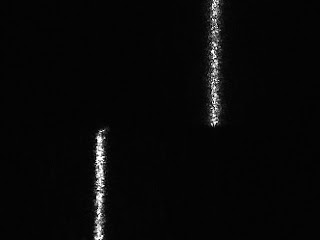I’m doing a lot of laser triangulation-based 3D work these days. As you’ll know if you’ve ever dabbled in this particular machine vision niche, it all hinges on finding the center of a laser line.
This image shows a very simple example. It’s a laser line projected onto a stepped surface, viewed from 45 degrees. The difference in the x coordinates of each line can be used to tell the height of the step.
Unfortunately, the lines are not homogeneous, which makes finding the center rather non-trivial.
This lack of homogeneity is down to speckle, which results from the laser emitting coherent monochromatic light. The best explanation I’ve found of why this creates speckle is in Wikipedia – not the most authoritative source, I know, but the analogy given there works for me.
But knowing what causes speckle doesn’t lead to an obvious solution, unless you read the definition given on “The Encyclopedia of Laser Physics and Technology” website. The first paragraph of this article ends with the sentence, “Even minor changes of the conditions, such as of the illuminated spot or the direction of the incident laser beam, can change the detailed shape of a speckle pattern.”
What that means is motion disturbs the speckle. Logically then, if you can disturb the speckle quickly, a relatively long exposure will blur it out, giving a laser line image that’s more uniform.
That’s the principle behind the laser speckle reducers sold on the Edmund Optics website and developed by Swiss start-up Optotune. If you go to their home page you’ll find an excellent video explaining the technology and showing what it does.
Doubtless, these are good products, but for most of us I suspect there’s an easier/simpler/cheaper solution. Defocus the lens just a fraction, maximize the exposure time, and put the target surface in motion. You’ll then have a cleaner, more contiguous laser line with which to work.






2 comments:
One can also use LED pattern projector.
The LED pattern projectors that I know of are much lower power than laser line projectors. This means longer exposures are needed which hits cycle time/part rate in a production environment.
Post a Comment